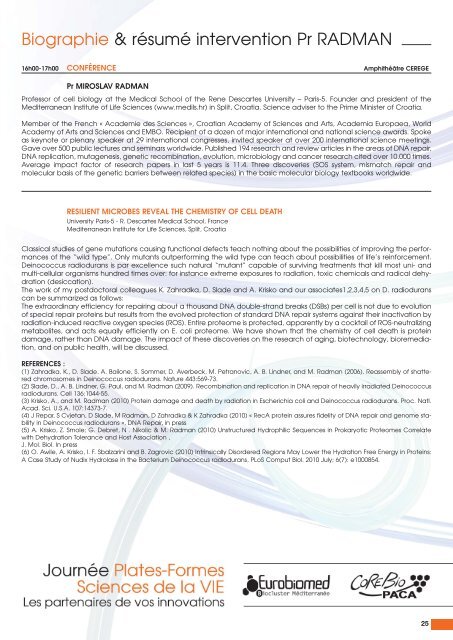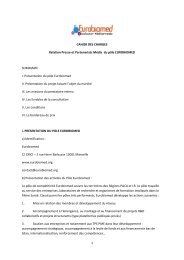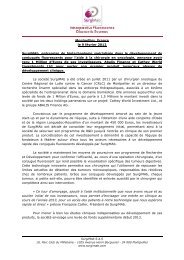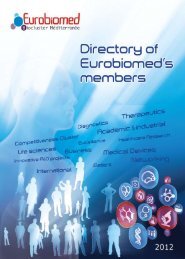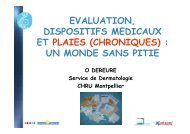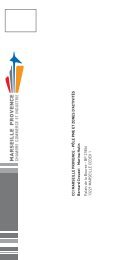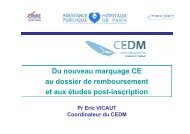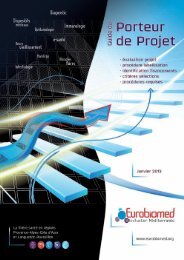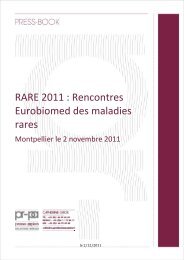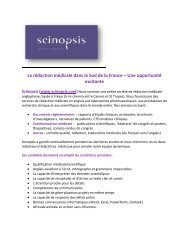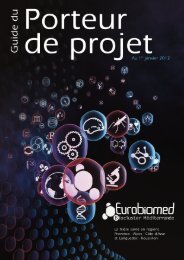Prog de 1Ã 28 - Eurobiomed
Prog de 1Ã 28 - Eurobiomed
Prog de 1Ã 28 - Eurobiomed
You also want an ePaper? Increase the reach of your titles
YUMPU automatically turns print PDFs into web optimized ePapers that Google loves.
Biographie & résumé intervention Pr RADMAN16h00-17h00 CONFÉRENCE Amphithéâtre CEREGEPr MIROSLAV RADMANProfessor of cell biology at the Medical School of the Rene Descartes University – Paris-5. Foun<strong>de</strong>r and presi<strong>de</strong>nt of theMediterranean Institute of Life Sciences (www.medils.hr) in Split, Croatia. Science adviser to the Prime Minister of Croatia.Member of the French « Aca<strong>de</strong>mie <strong>de</strong>s Sciences », Croatian Aca<strong>de</strong>my of Sciences and Arts, Aca<strong>de</strong>mia Europaea, WorldAca<strong>de</strong>my of Arts and Sciences and EMBO. Recipient of a dozen of major international and national science awards. Spokeas keynote or plenary speaker at 29 international congresses, invited speaker at over 200 international science meetings.Gave over 500 public lectures and seminars worldwi<strong>de</strong>. Published 194 research and review articles in the areas of DNA repair,DNA replication, mutagenesis, genetic recombination, evolution, microbiology and cancer research cited over 10.000 times.Average impact factor of research papers in last 5 years is 11.4. Three discoveries (SOS system, mismatch repair andmolecular basis of the genetic barriers between related species) in the basic molecular biology textbooks worldwi<strong>de</strong>.RESILIENT MICROBES REVEAL THE CHEMISTRY OF CELL DEATHUniversity Paris-5 - R. Descartes Medical School, FranceMediterranean Institute for Life Sciences, Split, CroatiaClassical studies of gene mutations causing functional <strong>de</strong>fects teach nothing about the possibilities of improving the performancesof the “wild type”. Only mutants outperforming the wild type can teach about possibilities of life’s reinforcement.Deinococcus radiodurans is par excellence such natural “mutant” capable of surviving treatments that kill most uni- andmulti-cellular organisms hundred times over: for instance extreme exposures to radiation, toxic chemicals and radical <strong>de</strong>hydration(<strong>de</strong>siccation).The work of my postdoctoral colleagues K. Zahradka, D. Sla<strong>de</strong> and A. Krisko and our associates1,2,3,4,5 on D. radioduranscan be summarized as follows:The extraordinary efficiency for repairing about a thousand DNA double-strand breaks (DSBs) per cell is not due to evolutionof special repair proteins but results from the evolved protection of standard DNA repair systems against their inactivation byradiation-induced reactive oxygen species (ROS). Entire proteome is protected, apparently by a cocktail of ROS-neutralizingmetabolites, and acts equally efficiently on E. coli proteome. We have shown that the chemistry of cell <strong>de</strong>ath is proteindamage, rather than DNA damage. The impact of these discoveries on the research of aging, biotechnology, bioremediation,and on public health, will be discussed.REFERENCES :(1) Zahradka, K., D. Sla<strong>de</strong>, A. Bailone, S. Sommer, D. Averbeck, M. Petranovic, A. B. Lindner, and M. Radman (2006). Reassembly of shatteredchromosomes in Deinococcus radiodurans. Nature 443:569-73.(2) Sla<strong>de</strong>, D., A. B. Lindner, G. Paul, and M. Radman (2009). Recombination and replication in DNA repair of heavily irradiated Deinococcusradiodurans. Cell 136:1044-55.(3) Krisko, A., and M. Radman (2010) Protein damage and <strong>de</strong>ath by radiation in Escherichia coli and Deinococcus radiodurans. Proc. Natl.Acad. Sci. U.S.A. 107:14373-7.(4) J Repar, S Cvjetan, D Sla<strong>de</strong>, M Radman, D Zahradka & K Zahradka (2010) « RecA protein assures fi<strong>de</strong>lity of DNA repair and genome stabilityin Deinococcus radiodurans », DNA Repair, in press(5) A. Krisko, Z. Smole; G. Debret, N . Nikolic & M. Radman (2010) Unstructured Hydrophilic Sequences in Prokaryotic Proteomes Correlatewith Dehydration Tolerance and Host Association ,J. Mol. Biol. In press(6) O. Awile, A. Krisko, I. F. Sbalzarini and B. Zagrovic (2010) Intrinsically Disor<strong>de</strong>red Regions May Lower the Hydration Free Energy in Proteins:A Case Study of Nudix Hydrolase in the Bacterium Deinococcus radiodurans, PLoS Comput Biol. 2010 July; 6(7): e1000854.25


